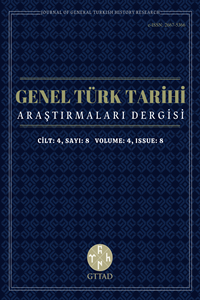Research Article
Review
Translation
Book Review
Issue Editorial Board


Prof. Dr. Farhod Maksudov https://orcid.org/0000-0002-8492-0634
Aim & Scope
General Turkish History Research Journal (GTTAD) aims to produce and present scientific researches on Turkish history and culture.
The Journal of General Turkish History Research is an International Peer-reviewed journal on the research of the history of Turks and the studies of the researchers who devoted their life to researching Turkish history.
With the accumulation of thousands of years of Turkish history; It aims to contribute to the publication of academic studies in the field of history and culture in Russia, Eastern Europe, Idil-Ural and Siberia, Caucasus, Iran and Turkistan.
The Turkish Journal of General Turkish History Studies deals with issues such as political history of the Turks, state traditions, social life, military and economic activities, religious beliefs, culture and mythologies, etc.
Author Guidelines
Text
1. In orthographic rules, the latest edition of Turkish Language Association’s Orthography Manual must be taken as a basis.
2. The article must be written with “Microsoft Word” programme, 10-font size and single line spacing.
3. The font must be “Times New Roman”
4. There must be 0, 8 cm space for indents.
5. The author’s name and surname must be written under the title after 12pt space with 10 font size and centre aligned. Title, address and e-mail information must be written at the bottom of the page with (*) mark and with 8 font size.
6. In articles and translations, there must be a summary which is independent from the article, between 200-300 words. At least 4, at most 8 keywords must be written under the summary after 1 line space.
7. Major headings must be written with uppercase letters, subheadings must be written with lower case letters except the first letter and must be in bold typeface.
8. The original titles of the translated articles must be reported to the institution.
References
1. References less than 5 lines must be written in italic typeface. Statements that must be emphasized must also be written in italic typeface.
2. When the reference exceed 5 lines, they must be written in inverted comas, 1cm further in from the indentation and the left side.
Footnotes
Footnotes must be written with 8 font size, single line space and with the same font.
Sources in the footnotes (books, thesis, encyclopaedia or journal names) must be written in italic typeface and authors name, surname, name of the source, number of the volume (if there is), publishing house, place of publication, and date and page numbers must be written in order.
Examples
- Bahaeddin Ögel, İslamiyetten Önce Türk Kültür Tarihi, Türk Tarih Kurumu, Ankara 1984, s.88.
Article or encyclopaedia item names in the footnotes must be written in quotation marks and regular typeface, periodical publications and encyclopaedia names in italic typeface.
For article or encyclopaedia item names in the footnotes, the authors name, surname, title of the article, periodical publication’s number or volume number, place of publication and date and page numbers must be written.
Examples
- W. Eberhard, “Orta Asya’da At Cinsleri ve Beygir Yetiştirme Hakkında Malumat”, Ülkü, 16/92, Ankara 1940, s.162.
- Ömer Faruk Akün, “Mehmed Fuad Köprülü” İslam Ansiklopedisi, C 28, İstanbul 2013, s. 473.
Scientific report names in the footnotes must be written in quotation marks and regular typeface and the name of the scientific event must be written in italic typeface. The author’s name, surname, reports title, the name of the event (assembly/symposium etc.), the place where it was held and the date, editor’s name, number of the volume, publishing house, publishing place, and date and page numbers will be written in order.
Example
-C.V.Uygur, “Dul (Tul) Kelimesine Dair”, XI. Milli Türkoloji Kongresi Bildirileri, C. I, İstanbul 2015, s.187-200.
For sources which has more than two authors, first two authors names must be written, and for the others “vd.” contraction must be used. But in the bibliography all authors must be written.
Example
- Ayşe Onat, Sema Orsoy, Konuralp Ercilasun, Han Hanedanlığı Tarihi, Ankara 2004, s.89.
For translated works, the author’s name and surname, name of the work, translators name and surname, number of the volume, publishing house, publishing place, date and page numbers must be written in order.
Example:
- Wilhelm Radloff, Türklerin Kökleri, çev. A.Ekinci-Y.Ünlü, C. III, Ankara 1999, s.122.
- L. N. Gumilev, Hunlar, çev. Ahsen Batur, Selenge, İstanbul 2003, s.140
For edited works, name and surname of the editor, name of the work, volume number, publishing house, place of publishing, date and page numbers must be written in order. For works which have an author and an editor, authors name and surname, name of the work, editors name and surname, volume number, publishing house, place of publishing, date and page numbers must be written.
Örnekler:
- Mehmet Emin Efendi, İstanbul’dan Orta Asya’ya Seyahat, Haz. R.Akdemir, Ankara 1986, s.124.
- İbn Fadlan, İbn Fadlan Seyahatnamesinden Seçmeler, Haz. Ramazan Şeşen, Bedir Yayınevi İstanbul 1975, s.77.
For sources which were acquired through the internet, the name of the source must be in quotation marks and author’s name and surname, name of the source, web page’s address, access date, and hour must be written in order.
Example
- Yasin Yusupcan, “Türk Kültürünün Çin Kültürü Üzerindeki Etkileri”, http://www.turkishstudies.net/sayilar/sayi16/yusupcanyasin1367.pdf 20.10.2018 sa.2351-2370.
For repeated references, the author’s name and surname, page numbers and age., agm., agy., according to the source type must be written.
Statements belonging to the person who editor, translator or compiler must be written as a footnote by using the haz., drl., and cev. Contractions.
Additional documents and Albums
All materials like pictures, figures and documents must be numbered and their explanations must be written below them in italic typeface and 10 font size.
References
References must be written at the end of the work. References can be grouped under names like feature of the work, archive resources, books, articles, thesis, encyclopaedia items, etc.
In this part first the surname, then the name of the author must take place. Other information about the work must be lined up according to the rules given in the “Footnotes” section.
References must be sorted according to the alphabetical order of the surnames.
In the references, only the works that are used or cited must be written.
Book, thesis, and journal names must be italic typeface, article or encyclopaedia names must be in regular typeface and quotation marks.
Examples
- Ögel, B. (1955). “Uygur Devleti’nin Teşekkülü ve Yükseliş Devri,” Belleten, XIX/75, s. 331-376.
- Ahmetbeyoğlu, Ali, Avrupa Hun İmparatorluğu, Yeditepe Ankara 2001.
- Caferoğlu, Ahmet, “Türk Onomastiğinde At Kültü”, Türkiyat Mecmuası, C. 10, İstanbul 1953
Pages of the articles and encyclopaedia items in the publications which they are published must also be written.
Examples
- Bakır, Abdulhalik, “Ortaçağ İslam Dünyasında Maden ve Maden Sanayi”, Belleten, 61/232, Ankara: 1997, 519-595.
- Ömer Faruk Akün, “Mehmed Fuad Köprülü” İslam Ansiklopedisi, C 28, İstanbul 2013, s. 471-486.
Ethical Principles and Publication Policy
Publication Ethics & Malpractice
Price Policy
For the articles published in the Journal of General Turkish History Research, no fee is paid to the author and no fee is charged from the author. The journal does not charge any fee for article submission, editorial processes or publication. Articles are freely available digitally.




